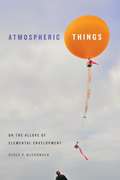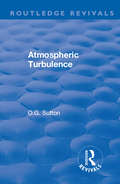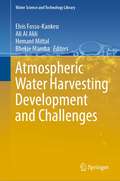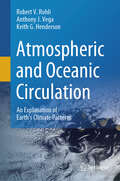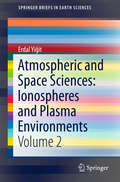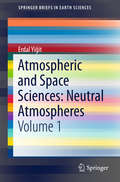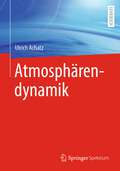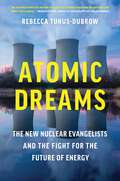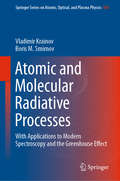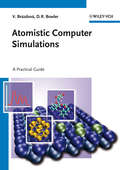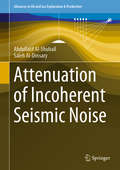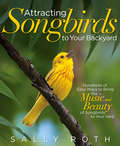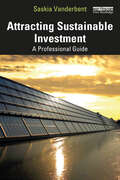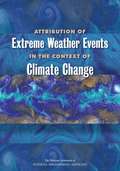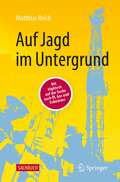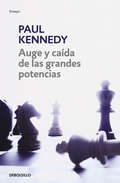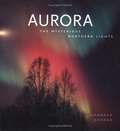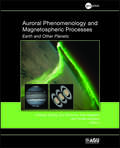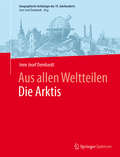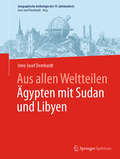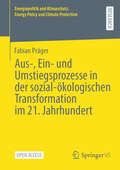- Table View
- List View
Atmospheric Things: On the Allure of Elemental Envelopment (Elements)
by Derek P. McCormackIn Atmospheric Things Derek P. McCormack explores how atmospheres are imagined, understood, and experienced through experiments with a deceptively simple object: the balloon. Since the invention of balloon flight in the late eighteenth century, balloons have drawn crowds at fairs and expositions, inspired the visions of artists and writers, and driven technological development from meteorology to military surveillance. By foregrounding the distinctive properties of the balloon, McCormack reveals its remarkable capacity to disclose the affective and meteorological dimensions of atmospheres. Drawing together different senses of the object, the elements, and experience, McCormack uses the balloon to show how practices and technologies of envelopment allow atmospheres to be generated, made meaningful, and modified. He traces the alluring entanglement of envelopment in artistic, political, and technological projects, from the 2009 Pixar movie Up and Andy Warhol’s 1966 installation Silver Clouds to the use of propaganda balloons during the Cold War and Google's experiments with delivering internet access with stratospheric balloons. In so doing, McCormack offers new ways to conceive of, sense, and value the atmospheres in which life is immersed.
Atmospheric Turbulence (Routledge Revivals)
by O.G. SuttonOriginally published in 1955 Atmospheric Turbulence examines dynamic meteorology and the fundamental part it plays in the overall science of meteorology. The book examines the theory of atmospheric turbulence as a more mathematically developed area than largescale motions of the atmosphere and examines its significance in economic, military and industrial spheres. The book focuses on the effect and importance of atmospheric turbulence, not only to meteorologists, but the designers of large aircraft. The book addresses the effects of turbulence and the properties of the atmosphere that can be found closer to the ground. This book will be of interest to atmospheric physicists and meteorologists.
Atmospheric Water Harvesting Development and Challenges (Water Science and Technology Library #122)
by Elvis Fosso-Kankeu Bhekie Mamba Ali Al Alili Hemant MittalThe commercial operation of atmospheric water harvesting systems is still limited to few countries; this is mainly due to the low energy efficiency of the system and the inability to effectively operate throughout the various seasons of the year. Researchers have attempted to develop strategies to render the operation of atmospheric water harvesters easier and cost effective. This book covers work progress toward such direction, including among others the co-operation of these systems with renewable energy source and the adaptation of the systems to local conditions; the response of the communities around the world to such technology and how its implementation is affected by cultural believe, cost, and technological friendliness. The book is of interest to academic researchers, students, water authorities, professional in relevant industries, government regulatory bodies officers, and environmentalists.
Atmospheric and Oceanic Circulation: An Explanation of Earth’s Climate Patterns
by Robert V. Rohli Anthony J. Vega Keith G. HendersonThis book provides a one-stop shop for coastal and marine scientists to understand processes that generate atmospheric circulation as integrated with terrestrial and oceanic circulation processes to create an Earth-ocean-atmosphere climate system. It uses the process approach in the first half of the book to set the stage for understanding circulation systems and then for explaining the circulation processes themselves, with the second half of the book dedicated to showing how these processes play themselves out across the Earth's terrestrial and marine surface. The processes explained in the first half of the book assume no prior knowledge of meteorology or oceanography. The regional section includes the major continents or subcontinents, along with their surrounding ocean environs. It begins with the area with which many/most readers are likely most familiar —the USA and Canada. From there, the tour of the world continues, beginning with the places that have atmospheric and oceanic circulation features that are most similar to the USA and Canada, all in the Northern Hemisphere—Europe, Southwestern Asia, and then East Asia. From there, the discussion builds on principles illustrated in the first half of the book and demonstrated in the beginning of the regional section of the book, while also adding concepts and principles of importance in the tropical and subtropical latitudes, by describing circulation features of South and Southeast Asia. This discussion carries forward naturally for a discussion of Africa, which experiences similar features of subtropical and tropical latitudes. From there, previous material can be applied and built upon further in the discussion of Latin America and the Caribbean. Australia and Oceania are the next area covered, followed by the polar latitudes. The book concludes with a brief review of the major atmospheric and oceanic circulation features around the world and with a reminder of the cascading primary and secondary impacts of the climate system. The book is intended to fill a niche as both a textbook and a reference source for non-atmospheric specialists. Its purpose is to help coastal, environmental, engineering, and planning professionals to get “up to speed” regarding atmospheric and oceanic circulations and their impacts around the world. This would allow more effective communication with climate modelers, atmospheric and marine environmental consultants, and media. Our book-writing experience allows us to implement “best practices” based on cognitive theory to facilitate learning in the geosciences.
Atmospheric and Oceanic Fluid Dynamics
by Geoffrey K. VallisFluid dynamics is fundamental to our understanding of the atmosphere and oceans. Although many of the same principles of fluid dynamics apply to both the atmosphere and oceans, textbooks tend to concentrate on the atmosphere, the ocean, or the theory of geophysical fluid dynamics (GFD). This textbook provides a comprehensive unified treatment of atmospheric and oceanic fluid dynamics. The book introduces the fundamentals of geophysical fluid dynamics, including rotation and stratification, vorticity and potential vorticity, and scaling and approximations. It discusses baroclinic and barotropic instabilities, wave-mean flow interactions and turbulence, and the general circulation of the atmosphere and ocean. Student problems and exercises are included at the end of each chapter. Atmospheric and Oceanic Fluid Dynamics: Fundamentals and Large-Scale Circulation will be an invaluable graduate textbook on advanced courses in GFD, meteorology, atmospheric science and oceanography, and an excellent review volume for researchers. Additional resources are available at www. cambridge. org/9780521849692.
Atmospheric and Space Sciences: Ionospheres and Plasma Environments (SpringerBriefs in Earth Sciences #2)
by Erdal YiğitThe SpringerBriefs on Atmospheric and Space Sciences in two volumes presents a concise and interdisciplinary introduction to the basic theory, observation & modeling of atmospheric and ionospheric coupling processes on Earth. The goal is to contribute toward bridging the gap between meteorology, aeronomy, and planetary science. In addition recent progress in several related research topics, such atmospheric wave coupling and variability, is discussed. <P><P>Volume 1 will focus on the atmosphere, while Volume 2 will present the ionospheres and the plasma environments. Volume 2 is aimed primarily at (research) students and young researchers that would like to gain quick insight into the basics of space sciences and current research. In combination with the first volume, it also is a useful tool for professors who would like to develop a course in atmospheric and space physics.
Atmospheric and Space Sciences: Volume 1 (SpringerBriefs in Earth Sciences)
by Erdal YiğitThe SpringerBriefs on Atmospheric and Space Sciences in two volumes presents a concise and interdisciplinary introduction to the basic theory, observation & modeling of atmospheric and ionospheric coupling processes on Earth. The goal is to contribute toward bridging the gap between meteorology, aeronomy, and planetary science. In addition recent progress in several related research topics, such atmospheric wave coupling and variability, is discussed. Volume 1 will focus on the atmosphere, while Volume 2 will present the ionosphere-- the plasma environment. Volume 1 is aimed primarily at (research) students and researchers that would like to gain quick insight in atmospheric sciences and current research. It also is a useful tool for professors who would like to develop a course in atmospheric physics.
Atmosphärendynamik
by Ulrich AchatzDieses Lehrbuch richtet sich an Studierende der Meteorologie sowie an Forschende zu theoretischen und numerischen Aspekten von Wetter und Klima. Der vorliegende Text konzentriert sich auf das Wesentliche und bleibt dabei gleichermaßen gründlich. Alle zum Verständnis notwendigen physikalischen Konzepte werden eingeführt.Einleitend erfolgt eine Herleitung der Grundgleichungen der Atmosphärendynamik. Diese werden nachfolgend herangezogen, um wesentliche Aspekte von Wetter und Klima zu erläutern, zu denen unter anderem die Mechanismen hinter den wirbelartigen Bewegungen auf der täglichen Wetterkarte gehören. Als Mittel zu einer effizienten Analyse von atmosphärischen Wellen folgt die Vereinfachung der Dynamik mithilfe der Flachwassergleichungen. Daraufhin wird unter Zuhilfenahme der quasigeostrophischen Theorie das Auftreten extratropischer Wettersysteme begründet. Dem schließt sich eine ausführliche Betrachtung der globalen atmosphärischen Zirkulation an, die maßgeblich dem Einfluss durch Rossby- und Schwerewellen unterliegt. Auch die spezifischen Eigenschaften der atmosphärischen Grenzschicht werden diskutiert. Im Mittelpunkt steht hier die Wechselwirkung zwischen Turbulenz und mittlerer Strömung.Im Zuge der Betrachtungen wird die Leserschaft mit wesentlichen theoretischen Konzepten des Gebiets vertraut gemacht. Hierzu zählen Entropie und potentielle Temperatur, potentielle Vorticity, Instabilitätstheorie, Reynoldsgleichungen, Mehrskalenasymptotik, WKB-Theorie, Wellenwirkung, Eliassen-Palm-Fluss, transformiertes Eulermittel, kritische Schichten, Wellenbeugung und vieles mehr.Der Text wird durch Anhänge zu mathematischen Methoden und weiteren Vertiefungen ergänzt. Kapitelzusammenfassungen helfen, den Blick auf das Wesentliche zu bewahren. Ergänzende Leseempfehlungen regen dazu an, das erworbene Wissen zu vertiefen und zu erweitern.
Atoll Island States and International Law: Climate Change Displacement and Sovereignty
by Lilian Yamamoto Miguel EstebanAtoll Island States exist on top of what is perceived to be one of the planet's most vulnerable ecosystems: atolls. It has been predicted that an increase in the pace of sea level rise brought about by increasing greenhouse gas concentrations in the atmosphere will cause them to disappear, forcing their inhabitants to migrate. The present book represents a multidisciplinary legal and engineering perspective on this problem, challenging some common misconceptions regarding atolls and their vulnerability to sea-level rise. Coral islands have survived past changes in sea levels, and it is the survival of coral reefs what will be crucial for their continued existence. These islands are important for their inhabitants as they represent not only their ancestral agricultural lands and heritage, but also a source of revenue through the exploitation of the maritime areas associated with them. However, even if faced with extreme climate change, it could theoretically be possible for the richer Atoll Island States to engineer ways to prevent their main islands from disappearing, though sadly not all will have the required financial resources to do so. As islands become progressively uninhabitable their residents will be forced to settle in foreign lands, and could become stateless if the Atoll Island State ceases to be recognized as a sovereign country. However, rather than tackling this problem by entering into lengthy negotiations over new treaties, more practical solutions, encompassing bilateral negotiations or the possibility of acquiring small new territories, should be explored. This would make it possible for Atoll Island States in the future to keep some sort of international sovereign personality, which could benefit the descendents of its present day inhabitants.
Atomic Dreams: The New Nuclear Evangelists and the Fight for the Future of Energy
by Rebecca Tuhus-DubrowThe inside story of how nuclear energy—long considered scary, controversial, and even apocalyptic—has become the hot topic of the climate debate, and perhaps a vital power source of the future On June 21, 2016, Pacific Gas & Electric Company announced a plan to shutter California&’s last nuclear power plant, Diablo Canyon, in 2025. The plan was hailed by environmental groups and politicians around the country. Then, in 2022, the state&’s Democratic establishment suddenly reversed the decision, and in 2024 the Biden-Harris administration awarded the plant $1.1 billion in credits to extend its life. What happened in between? In Atomic Dreams, journalist and lifelong environmentalist Rebecca Tuhus-Dubrow unearths the surprising answers—and the deep-seated conflicts behind them. She follows the fascinating and lively cast of characters who are immersed in the fight over Diablo Canyon and nuclear energy, among them a world-renowned climate scientist, a fashion model turned &“nuclear influencer,&” and two radically opposed groups of mothers, both fiercely advocating for the kind of planet they want their children to inherit. And she chronicles how nuclear power has morphed from the stuff of cinematic nightmares—associated with world-ending weapons and terrifying meltdowns—to a rare issue with strong bipartisan support. Tuhus-Dubrow takes readers to nuclear plants and research facilities, to the halls of Congress and into the streets with activists as she explores the big questions wrapped up in the nuclear debate: questions about risk and responsibility, about nature and technology, about whether humans should be humble caretakers of the Earth or audacious innovators. She explores how these issues affect real people&’s lives, and personally grapples with the viability of this controversial energy source. Can the power of the atom be freed from its historical baggage and reinvented? Could something that once threatened to doom us now hold the potential to save us?
Atomic and Molecular Radiative Processes: With Applications to Modern Spectroscopy and the Greenhouse Effect (Springer Series on Atomic, Optical, and Plasma Physics #108)
by Boris M. Smirnov Vladimir KrainovThis book describes selected problems in contemporary spectroscopy in the context of quantum mechanics and statistical physics. It focuses on elementary radiative processes involving atomic particles (atoms, molecules, ions), which include radiative transitions between discrete atomic states, the photoionization of atoms, photorecombination of electrons and ions, bremsstrahlung, photodissociation of molecules, and photoattachment of electrons to atoms. In addition to these processes, the transport of resonant radiation in atomic gases and propagation of infrared radiation in molecular gases are also considered. The book subsequently addresses applied problems such as optical pumping, cooling of gases via laser resonance radiation, light-induced drift of gas atoms, photoresonant plasma, reflection of radio waves from the ionosphere, and detection of submillimeter radiation using Rydberg atoms. Lastly, topical examples in atmospheric and climate change science are presented, such as lightning channel glowing, emission of the solar photosphere, and the greenhouse phenomenon in the atmospheres of the Earth and Venus. Along with researchers, both graduate and undergraduate students in atomic, molecular and atmospheric physics will find this book a useful and timely guide.
Atomistic Computer Simulations: A Practical Guide
by Veronika Brazdova David R. BowlerMany books explain the theory of atomistic computer simulations; this book teaches you how to run themThis introductory "how to" title enables readers to understand, plan, run, and analyze their own independent atomistic simulations, and decide which method to use and which questions to ask in their research project. It is written in a clear and precise language, focusing on a thorough understanding of the concepts behind the equations and how these are used in the simulations. As a result, readers will learn how to design the computational model and which parameters of the simulations are essential, as well as being able to assess whether the results are correct, find and correct errors, and extract the relevant information from the results. Finally, they will know which information needs to be included in their publications.This book includes checklists for planning projects, analyzing output files, and for troubleshooting, as well as pseudo keywords and case studies.The authors provide an accompanying blog for the book with worked examples, and additional material and references: http://www.atomisticsimulations.org/.
Attenuation of Incoherent Seismic Noise (Advances in Oil and Gas Exploration & Production)
by Abdullatif Al-Shuhail Saleh Al-DossaryThis book examines the effects of incoherent noise and how it leads to the misinterpretation of seismic data. It also reviews common noise reduction approaches and their drawbacks, focusing on developments that have occurred in the past decade. The main features of this book include: • Hands-on implementation in MATLAB and/or C • In-depth discussions of both theoretical and practical aspects of the subject • Supplementary, real-world seismic data • Detailed descriptions of structure-enhancing filters. Connecting the theory and practical implementation of noise reduction, the book helps readers fill the gap from equations to code, and from classical filters to the preservation and enhancement of a robust structure. Lastly, it highlights cutting-edge research in the area. As such, it is of interest to researchers in the fields of petroleum engineering, exploration seismology, and geophysics, as well as to practitioners working in the petroleum industry.
Attracting Native Pollinators: The Xerces Society Guide to Conserving North American Bees and Butterflies and Their Habitat
by The Xerces Society Dr Marla SpivakWith the recent decline of the European honey bee, it is more important than ever to encourage the activity of other native pollinators to keep your flowers beautiful and your grains and produce plentiful. In Attracting Native Pollinators, you’ll find ideas for building nesting structures and creating a welcoming habitat for an array of diverse pollinators that includes not only bees, but butterflies, moths, and more. Take action and protect North America’s food supply for the future, while at the same time enjoying a happily bustling landscape.
Attracting Songbirds to Your Backyard: Hundreds Of Easy Ways To Bring The Music And Beauty Of Songbirds To Your Yard
by Sally RothThe best ways to attract melodic birds, with insight into their rapidly changing habits The American robin and northern cardinal are two of the best-loved songbirds, but newer backyard arrivals, like rose-breasted grosbeaks and scarlet tanagers, quickly captivate with their vivid colors and unique songs. Bird lovers will learn to attract new visitors by offering treats that songbirds like best, such as soft, easy-to-peck foods that closely mimic caterpillars, their top food preference. And planting just a few carefree perennials and shrubs can provide opportunities for cover and nesting. Sally Roth's Attracting Songbirds to Your Backyard draws on the latest science and 50 years of observation to reveal these fascinating details: • In the wee hours, it's the robins that sing first, followed by the babble of house wrens and the whistle of cardinals • Some birds learn birdsongs throughout their lives, while others stop learning once they can mimic their parents' song • It's Dad, not Mom, who teaches the young birds to sing Simple tips, ideas, and recipes, as well as an understanding of why songbirds are coming from the treetops into the backyard, will help any bird enthusiast create a songbird sanctuary.
Attracting Sustainable Investment: A Professional Guide
by Saskia VanderbentThis book is a practitioner’s guide to sustainable development, laying out strategies for attracting investment for communities and their partners. It proposes an innovative Sustainable Development Proposition (SDP) decision-making tool based on a propositional calculus that can be used to analyse the sustainability of an infrastructure investment. It draws on environmental sustainability governance data analysis enabling investors to understand the economic indicators, income potential, return on investment, demand and legal compliance, as well as community and social benefits. Identified risks, issues and advantages are managed and monitored, and the SDP guidance can be applied to improve the prospects of the project in order to attract investment. Sustainable Community Investment Indicators (SCIIs™) have been developed to assist with attracting investment and monitoring feedback on infrastructure projects, designed by the author for remote rural and indigenous communities – in response to current industry tools that are designed for urban environments. The book includes a broad range of real-world and hypothetical case studies in agricultural and indigenous areas in South America, Europe, Africa, Asia, Australia and the Pacific. Taking a diverse economies approach, these industry tools can be adapted to allow for enterprise design with unique communities. This book provides sustainable development practitioners, including government agencies, financiers, developers, lawyers and engineers, with a positive, practical guide to addressing and overcoming global issues with local and community-based solutions and funding options.
Attribution of Extreme Weather Events in the Context of Climate Change
by Engineering Medicine National Academies of SciencesAs climate has warmed over recent years, a new pattern of more frequent and more intense weather events has unfolded across the globe. Climate models simulate such changes in extreme events, and some of the reasons for the changes are well understood. Warming increases the likelihood of extremely hot days and nights, favors increased atmospheric moisture that may result in more frequent heavy rainfall and snowfall, and leads to evaporation that can exacerbate droughts. Even with evidence of these broad trends, scientists cautioned in the past that individual weather events couldn’lt be attributed to climate change. Now, with advances in understanding the climate science behind extreme events and the science of extreme event attribution, such blanket statements may not be accurate. The relatively young science of extreme event attribution seeks to tease out the influence of human-cause climate change from other factors, such as natural sources of variability like El Niño, as contributors to individual extreme events. Event attribution can answer questions about how much climate change influenced the probability or intensity of a specific type of weather event. As event attribution capabilities improve, they could help inform choices about assessing and managing risk, and in guiding climate adaptation strategies. This report examines the current state of science of extreme weather attribution, and identifies ways to move the science forward to improve attribution capabilities.
Auf Jagd im Untergrund: Mit Hightech auf der Suche nach Öl, Gas und Erdwärme
by Matthias ReichDer ideale Einstieg in die faszinierende Welt der Tiefbohrtechnik Rohstoffe sind die Basis unseres Wohlstandes. Aber hätten Sie gewusst, dass Sie in Ihrem Leben statistisch gesehen zum Beispiel 460 Tonnen Sand verbrauchen oder dass in Ihrem Handy dutzende Elemente des Periodensystems verbaut sind, die alle mit großem Aufwand aus der Erdkruste gewonnen werden mussten? Das vorliegende Buch zeigt Ihnen, wie die fließfähigen Rohstoffe aufgesucht und erschlossen werden. Dazu zählen immer noch Erdöl und Erdgas, aber auch in zunehmendem Maße heißes Wasser, das als umweltfreundlicher geothermischer Energieträger eingesetzt wird. Die Suche nach flüssigen Rohstoffen ist ein Abenteuer der Superlative. Einige tausend Meter tief in der Erde herrschen extreme Bedingungen. Hier ist die moderne Tiefbohrtechnik zu Hause. Das Buch erklärt Ihnen in leicht verständlicher und anschaulicher Weise, wie moderne Tiefbohrungen „abgeteuft“ werden und welche enormen Anstrengungen dabei unternommen werden, um die Umwelt so wenig wie möglich zu belasten. >>Professor Dr. Reich ist es gelungen, ein Buch zu schreiben, das die Vielfältigkeit der „Oil and Gas Industry“ einem breiten Publikum zugänglich macht. Das Werk überzeugt durch seine verständlichen Begriffserklärungen und die Leichtigkeit der Darstellung komplexer Inhalte. Der Titel ist gerechtfertigt, es liest sich wie ein „Technik-Krimi“ – und lässt den Leser bis zum Ende nicht mehr los. Die begleitenden, vom Autor gezeichneten Karikaturen, helfen dem Leser auf unterhaltsame Weise, diese Technik intuitiv zu verstehen. Für alle, die einen Einstieg in die Welt der Tiefbohrtechnologie suchten und bisher ein Buch in deutscher Sprache vermissten!Prof. Dr. Dr. Ing. habil. Catalin Teodoriu, Institute of Subsurface Energy Systems der TU Clausthal und Drilling Simulation Center der University of Oklahoma>>Wie wunderbar! Endlich ein Buch, das die komplexe Tiefbohrtechnik dem Laien verständlich und spannend zugleich erklärt! Nicht jeder, der aufklärt, verfügt über diese besondere Begabung wie Prof. Dr. Reich, denn er kann komplexe Themen wirklich einfach vermitteln. Ich denke, dass dieses Buch behilflich sein kann, besorgten Menschen die Angst vor Bohrtürmen zu nehmen, denn es zeigt auch, wie groß Sicherheit und damit Umweltschutz geschrieben werden.Jürgen Lorenz, Tiefbohrtechniker
Auge y caída de las grandes potencias
by Paul KennedyEl análisis de un eminente historiador, que se sumerge en los últimos quinientos años de ascenso y caída de las grandes potencias. El eminente historiador Paul Kennedy analiza y describe el auge y la caída de las grandes potencias políticas, económicas y militares a lo largo de los últimos cinco siglos. La nación proyecta su poder militar según sus recursos económicos, pero el alto coste de mantener la supremacía militar la precipita a la decadencia. Las grandes potencias en crisis reaccionan gastando más en defensa y se debilitan desviando recursos productivos. A lo largo de la historia ha existido una significativa correlación entre las capacidades productivas y la fuerza militar, y el análisis de Kennedy permitirá al lector contar con las herramientas necesarias para comprender mejor la actual encrucijada mundial. La crítica ha dicho...«Excepcional. Parece haber leído todos los libros relevantes en todos los idiomas posibles. Y ha generado un argumento tan engañosamente simple que ningún político, por muy ocupadoque esté, debe ignorarlo o malinterpretarlo.»The Observer
Augusta Surviving Disaster: Surviving Disaster (Images of America)
by Misty A. TilsonAugusta: Surviving Disaster allows readers to glimpse the changes that mother nature and human error have wrought on the landscape and design of the "Garden City." These disasters did not only alter the city's landscape; many were the impetus for change in Augusta. The ravaging floods led to the construction of the levee along the Savannah River in 1919, to prevent flooding, and spurred the creation of the Clark Hill Dam and Reservoir. Within this volume, readers will get a glimpse of the damagecaused by the floodwaters of the Savannah River and the Augusta Canal. The remains of St. Paul's Episcopal Church, as well as other homes and businesses, after the Great Fire of 1916 are captured. Historic photographs reveal the damaged remains of the Lower Market after the 1878 tornado. Culled from the extensive collection of the Augusta Museum of History and the personal collection ofJoseph M. Lee III, these images provide testimony to the resiliency of the human spirit and the courage to move forward and rebuild. The citizens of Augusta have a long history of uniting for the common good, and this volume is a tribute to those who overcameobstacles to create the thriving community that exists today.
Aurora: The Mysterious Northern Lights
by Candace SavageExplore the Myth and Science Behind the Aurora Even those who have not had the privilege of seeing aurora know that there is something magical about them. Throughout the ages, the sheer magnificence and eerie grandeur of the northern lights have evoked both fear and wonder. But few of us understand why or how they occur. As beguiling as the auroral legends are, the scientific explanation for the lights is no less awe-inspiring. In a clear, intelligent text that is accompanied by dozens of archival illustrations, diagrams, and color photographs, Candace Savage explores the myth and science behind the aurora. She reveals the surprisingly common threads in the auroral traditions of distant cultures and follows the long, colorful, and sometimes fractious path that led scientists to the contemporary theory about the lights. Candace Savage is the author of numerous internationally acclaimed books of natural history, including Wolves, Grizzly Bears, Wild Cats and Bird Brains: The Intelligence of Crows, Ravens, Magpies and Jays. Her large body of work has been honored by the American and Canadian Library Associations, the Canadian Science Writers' Association and the Rachel Carson Institute. She lives in Saskatoon, Saskatchewan.
Auroral Phenomenology and Magnetospheric Processes: Earth and Other Planets
by Andreas Keiling Tomas Karlsson Eric Donovan Fran BagenalPublished by the American Geophysical Union as part of the Geophysical Monograph Series, Volume 197.Many of the most basic aspects of the aurora remain unexplained. While in the past terrestrial and planetary auroras have been largely treated in separate books, Auroral Phenomenology and Magnetospheric Processes: Earth and Other Planets takes a holistic approach, treating the aurora as a fundamental process and discussing the phenomenology, physics, and relationship with the respective planetary magnetospheres in one volume. While there are some behaviors common in auroras of the different planets, there are also striking differences that test our basic understanding of auroral processes. The objective, upon which this monograph is focused, is to connect our knowledge of auroral morphology to the physical processes in the magnetosphere that power and structure discrete and diffuse auroras. Understanding this connection will result in a more complete explanation of the aurora and also further the goal of being able to interpret the global auroral distributions as a dynamic map of the magnetosphere. The volume synthesizes five major areas: auroral phenomenology, aurora and ionospheric electrodynamics, discrete auroral acceleration, aurora and magnetospheric dynamics, and comparative planetary aurora. Covering the recent advances in observations, simulation, and theory, this book will serve a broad community of scientists, including graduate students, studying auroras at Mars, Earth, Saturn, and Jupiter. Projected beyond our solar system, it may also be of interest for astronomers who are looking for aurora-active exoplanets.
Aus allen Weltteilen Die Arktis (Geographische Anthologie des 19. Jahrhunderts)
by Imre Josef DemhardtGeographische Anthologie des 19. Jahrhunderts Auf den großen Erkundungsfahrten, die im 19. Jahrhundert einen glanzvollen Aufschwung erfahren hatten und maßgeblich an der Etablierung der wissenschaftlichen Disziplin der Geographie beteiligt waren, wurden wissenschaftliche Texte und detaillierte Karten erstellt. Von diesem als ,,geographisches Zeitalter" bezeichneten Jahrhundert gibt es etliche Artikel in geographischen Zeitschriften, die heute zum Teil nur noch schwer aufzufinden oder zugänglich sind. Diesen verborgenen Wissensschatz wieder zu heben, gilt das Interesse der Reihe Geographische Anthologie des 19. Jahrhunderts . Die Autoren bereiten Originaltexte und historisches Kartenmaterial für den modernen Leser durch aktuelle und zeitgemäße Erläuterungen auf und bieten so ein zuweilen vergessenes Panoptikum der Forscherfreudigkeit des 19. Jahrhunderts. Die Arktis, dieses riesige zumeist von Eis bedeckte Gebiet mit dem Nordpol als jahrhundertelangem Sehnsuchtspunkt, war im 19. Jahrhundert das Ziel einer Welle von Expeditionen, die schlussendlich zum Erreichen des Nordpols führten. Die Erkundung der Nordost- wie auch der Nordwestpassage sowie die Entdeckung von Franz-Josef-Land waren weitere bedeutsame Landmarken jener Zeit. Josef Demhardt focussiert sich in diesem Buch auf Auszüge aus dem von Carl Weyprecht in den Mitteilungen der k. k. Geographischen Gesellschaft in Wien verfassten Expeditionsbericht nach Franz-Josef-Land. Die eindrucksvollen Originaltexte, die der Autor kommentiert, nehmen auch den heutigen Leser gefangen und lassen ihn an diesen vergangenen Expeditionen teilhaben.
Aus allen Weltteilen Ägypten mit Sudan und Libyen
by Imre Josef DemhardtGeographen des 19. und frühen 20. Jahrhunderts sammelten auf ihren Reisen faszinierende Erkenntnisse, die sie in deutschsprachigen wissenschaftlichen Zeitschriften (wie Petermanns Geographische Mitteilungen) umfassend erläuterten. Demhardt interpretiert diese Forschungs aus heutiger Sicht, was war neu, was hat sich bewährt, was wurde umgestoßen an Erkenntnissen. Oftmals ist es erstaunlich, welches Wissen damals bereits vorhanden war und heute vielfach in Vergessenheit geraten ist.
Aus-, Ein- und Umstiegsprozesse in der sozial-ökologischen Transformation im 21. Jahrhundert (Energiepolitik und Klimaschutz. Energy Policy and Climate Protection)
by Fabian PrägerDiese Open-Access-Publikation analysiert die Aus-, Ein- und Umstiegsprozesse in der sozial-ökologischen Transformation des 21. Jahrhunderts. Basierend auf den Erkenntnissen der Forschungsarbeiten werden Maßnahmen zur Weiterentwicklung der Energieinfrastrukturentwicklung für eine 100%-Erneuerbare-Energien-Ökonomie erarbeitet. Das Promotionsprojekt beruht auf der Entwicklung und Anwendung eines Forschungsansatzes, der hier als „angewandte Transformationsforschung“ beschrieben wird und sowohl interdisziplinäre als auch transdisziplinäre Wissensproduktion integriert. Der Band untersucht die Notwendigkeit der sozial-ökologischen Transformation, um grundlegende Maßnahmen zu formulieren und ein fundiertes Verständnis für die Entwicklung eines 100%-Erneuerbare-Energiesystems zu schaffen, das den existenziellen Herausforderungen der Klimakrise effektiv begegnet. Zukunftsfähige Maßnahmen und Konzepte für die Energieinfrastrukturplanung werden entwickelt, indem die Theorien der Vordenker*innen der Energiewende analytisch aufgearbeitet sowie aktuelle fossile narrative Barrieren und Verhinderungsstrategien der Energiewende beschrieben und dekonstruiert werden. Die Erkenntnisse werden in tiefgreifende, überwiegend qualitative sozio-technische Sektoranalysen eingebettet.
